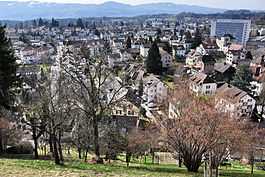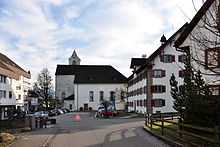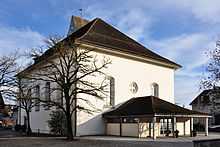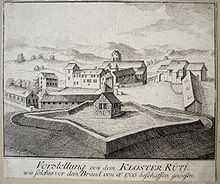Rüti, Zürich
| Rüti | ||
|---|---|---|
 | ||
| ||
 Rüti | ||
|
Location of Rüti  | ||
| Coordinates: 47°16′N 8°51′E / 47.267°N 8.850°ECoordinates: 47°16′N 8°51′E / 47.267°N 8.850°E | ||
| Country | Switzerland | |
| Canton | Zurich | |
| District | Hinwil | |
| Area[1] | ||
| • Total | 10.06 km2 (3.88 sq mi) | |
| Elevation | 482 m (1,581 ft) | |
| Population (Dec 2013[2]) | ||
| • Total | 11,928 | |
| • Density | 1,200/km2 (3,100/sq mi) | |
| Postal code | 8630 | |
| SFOS number | 0118 | |
| Surrounded by | Bubikon, Dürnten-Tann, Eschenbach (SG), Rapperswil-Jona (SG), Wald | |
| Website |
www SFSO statistics | |





Rüti is a municipality in the district of Hinwil in the canton of Zürich in Switzerland. Jona river flows through the municipality.
History

In 807, Rüti's quarter Fägswil was first mentioned in a document of the Abbey of Saint Gall. In a document of the German Emperor Otto II (972), the municipality was described as Riutun,[3] the Old High German word for Roden (= to convert forest into farmland), and later forwarded to the name of Rüti. In 1206, Rüti Abbey was given by Liutold IV, Duke of Regensberg. In 1408, Rüti and the Premonstratensian monastery came as part of the so-called Herrschaft Grüningen under the reign of the government of the city of Zürich. In 1525 (Reformation in Zürich), the abbey was secularized and managed as Amt Rüti by an Amtmann (member of the city of Zürich government) until 1798.
In mid 16th century, Rüti got one of the first public schools in the canton of Zürich, established by the Zurich reformers and the former monks of the Rüti Abbey. In 1866, the first Catholic Mass in the Zürcher Oberland was celebrated after the Reformation; in Tann ZH (politically part of the municipality Dürnten), the Catholic parish church was built in 1963.
Geography
Rüti has an area of 10.1 km2 (3.9 sq mi). Of this area, 36.4% is used for agricultural purposes, while 35.4% is forested. Of the rest of the land, 26.9% is settled (buildings or roads) and the remainder (1.4%) is non-productive (rivers, glaciers or mountains).[4] In 1996 housing and buildings made up 19.9% of the total area, while transportation infrastructure made up the rest (7%).[5] Of the total unproductive area, water (streams and lakes) made up 0.8% of the area. As of 2007 25.9% of the total municipal area was undergoing some type of construction.[5]
The municipality is located on at the confluence of the Jona and Schwarz rivers. It includes the hamlets of Weid, Moos, Weier and Fägswil. It grew up around the Rüti Abbey, which was built at the bridge along the pilgrimage route through the Thurgau to Einsiedeln Abbey.
Economy
Beginning in the Middle Ages, its hydropower was used for watermills along the Jona River, later for textile production facilities. In early 19th century, Rüti was one of the centers of the industrialization in the southeastern parts of the canton of Zürich. In 1847, Caspar Honegger, a factory for weaving machines, was established in the Joweid valley (Jona river), later Maschinenfabrik Rüti AG with its global relations, and in the 1990s of Sulzer and the G + F group.
The Rüti hospital, later district Hospital, was built in 1875 (in 2000, for financial and political reasons it has been closed). The community services began its activities in 1897, the Swiss Post established an office in 1911. Today, the recruitment center of the Swiss Army and civil defense for the cantons of Zurich, Schaffhausen and Thurgau, is located in the former hospital buildings. Rüti has nine school buildings and a variety of shopping malls, too.
Rüti has an unemployment rate of 2.77%. As of 2005, there were 106 people employed in the primary economic sector and about 34 businesses involved in this sector. 1532 people are employed in the secondary sector and there are 111 businesses in this sector. 2431 people are employed in the tertiary sector, with 429 businesses in this sector.[4] As of 2007 40% of the working population were employed full-time, and 60% were employed part-time.[5]
Demographics
Rüti has a population (as of 31 December 2013) of 11,928.[2] As of 2007, 21.0% of the population was made up of foreign nationals. As of 2008 the gender distribution of the population was 49.7% male and 50.3% female. Over the last 10 years the population has grown at a rate of 7.4%. Most of the population (as of 2000) speaks German (85.5%), with Italian being second most common ( 4.6%) and Serbo-Croatian being third ( 2.0%).
In the 2007 election the most popular party was the SVP which received 36.1% of the vote. The next three most popular parties were the SPS (16.9%), the CVP (12.2%) and the CSP (11.5%).
The age distribution of the population (as of 2000) is children and teenagers (0–19 years old) make up 23.8% of the population, while adults (20–64 years old) make up 61.5% and seniors (over 64 years old) make up 14.7%. The entire Swiss population is generally well educated. In Rüti about 69.9% of the population (between age 25-64) have completed either non-mandatory upper secondary education or additional higher education (either university or a Fachhochschule).[4] There are 4691 households in Rüti.[5]
As of 2008 there were 3871 Catholics and 4102 Protestants in Rüti. In the 2000 census, religion was broken down into several smaller categories. From the 2000 census, 41.5% were some type of Protestant, with 38% belonging to the Swiss Reformed Church and 3.5% belonging to other Protestant churches. 35.6% of the population were Catholic. Of the rest of the population, 7.5% were Muslim, 9.6% belonged to another religion (not listed), 3.6% did not give a religion, and 8.5% were atheist or agnostic.[5]
The historical population is given in the following table:[3]
| year | population |
|---|---|
| 1634 | 139a |
| 1764 | 701 |
| 1850 | 1,292 |
| 1900 | 4,796 |
| 1950 | 6,647 |
| 1970 | 9,546 |
| 1990 | 10,513 |
- ^a population not including Fägswil.
Transport
In 1833, Rüti was connected to the cantonal road network (since 1980's the Oberland Autobahn, A53 highway). In 1859, the Zürich-Rapperswil railway was established, electrified in 1932, and is now part of the S-Bahn Zürich. Rüti ZH railway station is a stop of the lines S15 and S5; its train station is a 28 minute (S5) ride from Zürich Hauptbahnhof. Tösstalbahn (S-Bahn Zürich line S26) is ending in Rüti.
Rüti today
For the first time, Rüti's population reached the limit of 10,000 in 1971/1972. On cultural matters, in Rüti is a variety of clubs, a local museum, a library with community and an antiquarian society located. In 2007, Rüti's 1200th anniversary with various events and festivals was celebrated.
References
- ↑ Arealstatistik Standard - Gemeindedaten nach 4 Hauptbereichen
- ↑ 2.0 2.1 Canton of Zurich Statistical Office (German) accessed 11 March 2014
- ↑ 3.0 3.1 Rüti in German, French and Italian in the online Historical Dictionary of Switzerland.
- ↑ 4.0 4.1 4.2 Swiss Federal Statistical Office accessed 06-Aug-2009
- ↑ 5.0 5.1 5.2 5.3 5.4 Statistics Zurich (German) accessed 4 August 2009
External links
![]() Media related to Rüti ZH at Wikimedia Commons
Media related to Rüti ZH at Wikimedia Commons
- Official website (German)
- Rüti in German, French and Italian in the online Historical Dictionary of Switzerland.
- Rüti Abbey in German, French and Italian in the online Historical Dictionary of Switzerland.
| ||||||||
